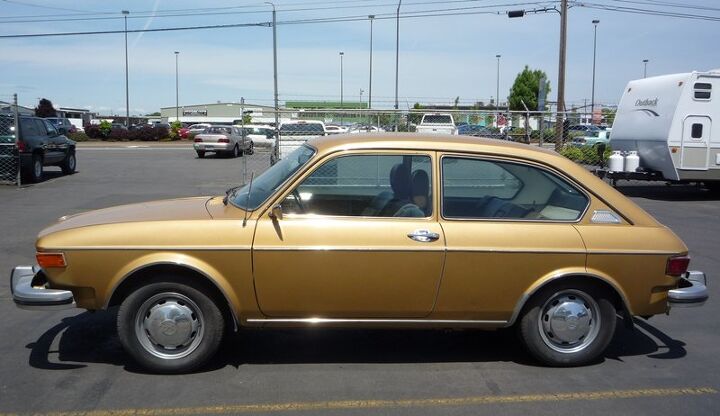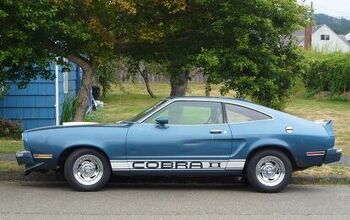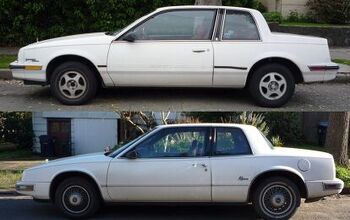Curbside Classic: Volkswagen's Deadly Sin #1: 1974 412

Every good idea has its time in the sun, but the trick is to get out of it before skin cancer appears. The rear engine configuration was once a sensation, especially in the form of the ground-breaking and wind-splitting Tatra 77 in 1934. Ferdinand Porsche adopted it as his own for his various VW prototypes that led to the seminal Beetle of 1938. But by the late sixties, the Europeans’ interest was rapidly shifting to FWD. Not VW. Quite lost and confused amidst all the excitement about FWD, and becoming dangerously conservative, VW developed and built what would be the final blowout of the rear-engined sedan: the 411/412. It has been referred to as VW’s Edsel.
To get a little history and perspective on the 411/412, one only needs to look at…the 311 (above). A prototype (EA 142) designed to replace the Type 3 (1500/1600), it was, for conservative VW, a big step. The 311 had a unitized body, instead of the platform frame of the Beetle and Type 3. And it was styled with the help of Pininfarina. But VW chickened out, and instead just grafted a longer nose on the cramped and obsolete Type 3. But having come this far, and needing a bigger sedan to compete against the very popular Opel Rekord, the basic design was blown up a bit and became the the 411.
Introduced in Europe in 1968, the 411 (above) quickly fell on its long face. It was (finally) roomy, and solidly built, like all VWs, but the rear engine concept now showed its limitations. The air-cooled 1.7 L boxer four was slow and thirsty. Despite the big schnozz, luggage space still wasn’t up to par. And it was priced too high. Sales never took off, which alarmed VW. It undoubtedly led to the decision to quickly rebadge the very advanced FWD NSU K70 as a Volkswagen, after VW bought that foundering company. But even that was a stop-gap, until VW wised up and just adopted the very successful B1 Audi 80/Fox platform for its Passat ( CC here).
Well, at least it did have four doors, which alone was revolutionary for a VW. That gave rise to a popular saying about the 411’s name: four doors, eleven years too late.
Starting out with only 68 hp didn’t help either; the following year a somewhat more potent 80 hp fuel injected engine came along. But even that was modest, for a car that was exactly the size and weight of the Corvair, which had a much larger six cylinder engine. For whatever reason, the 411/412 didn’t make it to the US until 1971, two years after the Corvair’s demise, to take up the banner for the genre.
Even if the 411 was conservative for European standards, it did introduce a host of new design/build elements to VW. The unitized body, MacPherson strut front suspension, non-swing axle rear suspension, automatic transmission and disc brakes came out of the 311/411 development, and soon showed up in other VW products, with varying degrees of success. But after Fiat’s brilliant 128 appeared in 1969, the template for modern FWD cars was set, and VW efforts really all amounted to rearranging the Titanic’s deck chairs.
The 412 appeared in 1972, with a revised nose and a slightly bigger 1.8 L engine. Not that it really made any difference. The 412’s reputation for being underpowered and thirsty was now cemented in the public’s mind. And the sales numbers confirmed it: In its six year run, VW managed to sell a total of 368k of them globally, of which only 117k went to the US. This is during a time when VW was used to selling almost a half-million Beetles to eager Americans annually.
Like the smaller squareback, the Variant/Wagon was by far the most successful 411/412 version, IMHO. The very low and flat engine meant that there was a considerable amount of room above it in the rear. And then there was still that fairly decent sized trunk up front. And the rear engine gave it superb traction, of course. The fact that the sedans didn’t have a hatchback made its configuration less versatile. Now if only VW had made a four-door wagon version, it would have been a true successor to the remarkable but equally unloved Corvair wagon.
If you’ve noticed that the sedan I shot seems to be sitting nose high, you’re right. It is, by design: In typical Germanic fashion, VW wanted to make sure the 411 had plenty of front luggage capacity (weight wise) to counter any critics. It’s rated for 220kg (almost 500 lbs), hence the big springs. The owner of the wagon above did what many 411/412 owners do: cut down the front spring and have that nose be pointing back at the earth instead of the sun.
The 411/412 shares quite a bit in common with the VW/Porsche 914, which recently earned Deadly Sin status here by JB. Ironically, I find the 914 a much more successful concept than the 411/412, and I’ll do a rebuttal on one soon. But what would have been interesting is a 911-powered 411/412, to take up the rear-engined battle where the Corvair Corsa left off. Then the 411 name would have had some real meaning.

More by Paul Niedermeyer
Latest Car Reviews
Read moreLatest Product Reviews
Read moreRecent Comments
- Bkojote @Lou_BC I don't know how broad of a difference in capability there is between 2 door and 4 door broncos or even Wranglers as I can't speak to that from experience. Generally the consensus is while a Tacoma/4Runner is ~10% less capable on 'difficult' trails they're significantly more pleasant to drive on the way to the trails and actually pleasant the other 90% of the time. I'm guessing the Trailhunter narrows that gap even more and is probably almost as capable as a 4 Door Bronco Sasquatch but significantly more pleasant/fuel efficient on the road. To wit, just about everyone in our group with a 4Runner bought a second set of wheels/tires for when it sees road duty. Everyone in our group with a Bronco bought a second vehicle...
- Aja8888 No.
- 2manyvettes Since all of my cars have V8 gas engines (with one exception, a V6) guess what my opinion is about a cheap EV. And there is even a Tesla supercharger all of a mile from my house.
- Cla65691460 April 24 (Reuters) - A made-in-China electric vehicle will hit U.S. dealers this summer offering power and efficiency similar to the Tesla Model Y, the world's best-selling EV, but for about $8,000 less.
- RHD The analyses above are on the nose.It's a hell of a good car, but the mileage is reaching the point where things that should have worn out a long time ago, and didn't, will, such as the alternator, starter, exhaust system, PS pump, and so on. The interiors tend to be the first thing to show wear, other than the tires, of course. The price is too high for a car that probably has less than a hundred thousand miles left in it without major repairs. A complete inspection is warranted, of course, and then a lower offer based on what it needs. Ten grand for any 18-year-old car is a pretty good chunk of change. It would be a very enjoyable, ride, though.








































Comments
Join the conversation
I had one of these back in Denver in 1997. It was terrible. No, it was infernal. Mine never had the fortune of being made into a bomb, but I agree with the previous poster- who felt that the RAF may have just been sick of it, or the car exploded on its own and was thought to be a car bomb. Mine was rust free, as with many western cars, but the vinyl seats had ripped so much that the chromed metal frames poked thorugh. It also had an unsolvable starting problem, which killed the battery. Now, jumpstarting a beetle is bad, but the 412 had the battery under the driver's seat- so if you're pumping the gas to get it going, any battery explosion will result in you applying for adoption if you want children. Not good. Mine would randomly not start for no reason- and wost of all, the engine compartment lid was about the size of a tea tray- so double articulated wrists were necessary for removal of the rear spark plugs. I think the Haynes manual section for spark plug service got to step six before stating 'refer to chapter one engine removal procedures'. When it would start, which would be entirely random, the same tape that jammed in would come on- Bauhaus's Bella Lugosi's dead- and I remember the car firing to life to the chorus of 'undead undead undead!!!' I sold it to somebody just before I left town for New Orleans. If the buyer is reading now, I can only say I'm sorry. Truly sorry. The only car I had that was worse than this heap was a 1983 Lancia Gamma- but that's another story entirely.
Ironicly my first car was a 74 412 four door sedan followed by a 62 Corvair Monza Wagon with a powerglide. What I learned was they were always cold. I nearly froze solid in both of them, they would climb a glass wall and they were quite the trick to drive quickly. That back end would come around on you faster than you could spit. The more powerful Corvair would swing even faster than the 412 but it still was no picnic. The front end would not track on slick surfaces either leaving the rear to its own devices... the next car was a Subaru.